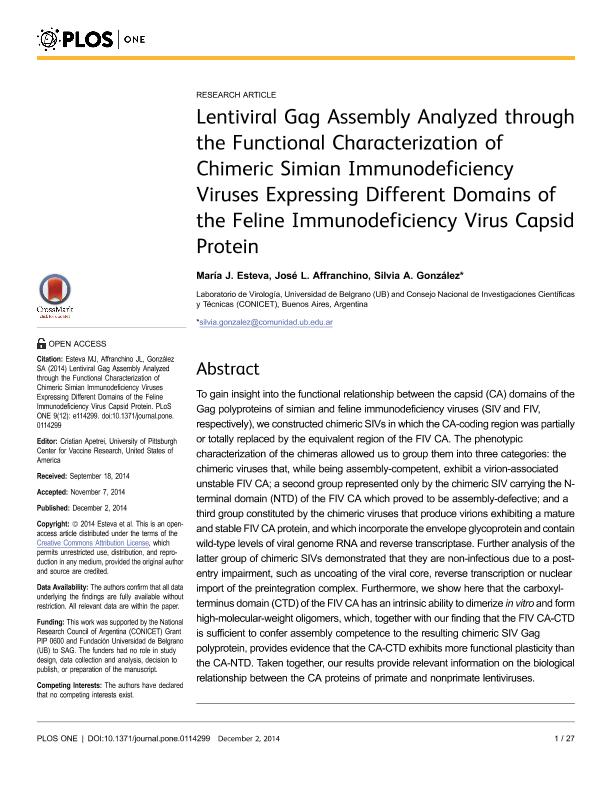Mostrar el registro sencillo del ítem
dc.contributor.author
Esteva, Maria Jimena

dc.contributor.author
Affranchino, Jose Luis

dc.contributor.author
Gonzalez, Silvia Adriana

dc.date.available
2018-02-26T22:12:57Z
dc.date.issued
2014-12
dc.identifier.citation
Esteva, Maria Jimena; Affranchino, Jose Luis; Gonzalez, Silvia Adriana; Lentiviral Gag assembly analyzed through the functional characterization of chimeric simian immunodeficiency viruses expressing different domains of the feline immunodeficiency virus capsid protein e114299; Public Library of Science; Plos One; 9; 12; 12-2014; 1-27; e114299
dc.identifier.issn
1932-6203
dc.identifier.uri
http://hdl.handle.net/11336/37220
dc.description.abstract
To gain insight into the functional relationship between the capsid (CA) domains of the Gag polyproteins of simian and feline immunodeficiency viruses (SIV and FIV, respectively), we constructed chimeric SIVs in which the CA-coding region was partially or totally replaced by the equivalent region of the FIV CA. The phenotypic characterization of the chimeras allowed us to group them into three categories: the chimeric viruses that, while being assembly-competent, exhibit a virion-associated unstable FIV CA; a second group represented only by the chimeric SIV carrying the N-terminal domain (NTD) of the FIV CA which proved to be assembly-defective; and a third group constituted by the chimeric viruses that produce virions exhibiting a mature and stable FIV CA protein, and which incorporate the envelope glycoprotein and contain wild-type levels of viral genome RNA and reverse transcriptase. Further analysis of the latter group of chimeric SIVs demonstrated that they are non-infectious due to a post-entry impairment, such as uncoating of the viral core, reverse transcription or nuclear import of the preintegration complex. Furthermore, we show here that the carboxylterminus domain (CTD) of the FIV CA has an intrinsic ability to dimerize in vitro and form high-molecular-weight oligomers, which, together with our finding that the FIV CA-CTD is sufficient to confer assembly competence to the resulting chimeric SIV Gag polyprotein, provides evidence that the CA-CTD exhibits more functional plasticity than the CA-NTD. Taken together, our results provide relevant information on the biological relationship between the CA proteins of primate and nonprimate lentiviruses.
dc.format
application/pdf
dc.language.iso
eng
dc.publisher
Public Library of Science

dc.rights
info:eu-repo/semantics/openAccess
dc.rights.uri
https://creativecommons.org/licenses/by/2.5/ar/
dc.subject
Siv
dc.subject
Fiv
dc.subject
Lentiviral Capsid Protein
dc.subject
Gag
dc.subject
Virus Replication
dc.subject.classification
Otras Ciencias Biológicas

dc.subject.classification
Ciencias Biológicas

dc.subject.classification
CIENCIAS NATURALES Y EXACTAS

dc.subject.classification
Otras Ciencias Biológicas

dc.subject.classification
Ciencias Biológicas

dc.subject.classification
CIENCIAS NATURALES Y EXACTAS

dc.title
Lentiviral Gag assembly analyzed through the functional characterization of chimeric simian immunodeficiency viruses expressing different domains of the feline immunodeficiency virus capsid protein e114299
dc.type
info:eu-repo/semantics/article
dc.type
info:ar-repo/semantics/artículo
dc.type
info:eu-repo/semantics/publishedVersion
dc.date.updated
2018-02-26T15:07:38Z
dc.journal.volume
9
dc.journal.number
12
dc.journal.pagination
1-27; e114299
dc.journal.pais
Estados Unidos

dc.journal.ciudad
San Francisco
dc.description.fil
Fil: Esteva, Maria Jimena. Consejo Nacional de Investigaciones Científicas y Técnicas; Argentina. Universidad de Belgrano. Facultad de Ciencias Exactas y Naturales. Laboratorio de Virología; Argentina
dc.description.fil
Fil: Affranchino, Jose Luis. Consejo Nacional de Investigaciones Científicas y Técnicas; Argentina. Universidad de Belgrano. Facultad de Ciencias Exactas y Naturales. Laboratorio de Virología; Argentina
dc.description.fil
Fil: Gonzalez, Silvia Adriana. Universidad de Belgrano. Facultad de Ciencias Exactas y Naturales. Laboratorio de Virología; Argentina. Consejo Nacional de Investigaciones Científicas y Técnicas; Argentina
dc.journal.title
Plos One

dc.relation.alternativeid
info:eu-repo/semantics/altIdentifier/doi/http://dx.doi.org/10.1371/journal.pone.0114299
dc.relation.alternativeid
info:eu-repo/semantics/altIdentifier/url/http://journals.plos.org/plosone/article?id=10.1371/journal.pone.0114299
Archivos asociados
